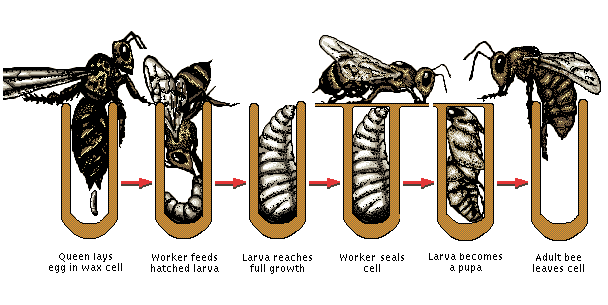Life Cycle of a Bee
A bee is like a butterfly because it goes through several stages in its life. Keep reading to find out about a bee's life.
Egg
A queen lays soft white eggs in the comb. The egg stage takes place during days 1 through 3.

Larva
In three days, the egg hatches into a larva. Workers feed it bee milk and bee bread. It spins a cocoon around itself. The larva stage takes place during days 4 through 9.
Pupa
In the cocoon, the larva turns into a pupa. It now has eyes, wings, and legs. It looks more like a bee. This stage is during days 10 through 23, depending on the type of bee it will become.
Adult
This is the final stage in a bee's complete metamorphosis. It is full grown. The bee chews its way out of the cell. It becomes an adult on days 16 through 24, depending on what type of bee it is.
Development Factor of Bee
Development from egg to emerging bee varies among queens, workers and drones. Queens emerge from their cells in 16 days, workers in 21 days and drones in 24 days. Only one queen is usually present in a hive. New virgin queens develop in enlarged cells through differential feeding of royal jelly by workers. When the existing queen ages or dies or the colony becomes very large a new queen is raised by the worker bees. The virgin queen takes one or several nuptial flights and once she is established starts laying eggs in the hive.
A fertile queen is able to lay fertilized or unfertilized eggs. The unfertilized eggs develop into drones and the fertilized eggs develop into either workers or virgin queens. The average lifespan of a queen is three to four years; drones usually die upon mating or are expelled from the hive before hibernation; and workers may live for a few weeks in the summer and several months in areas with an extended winter.